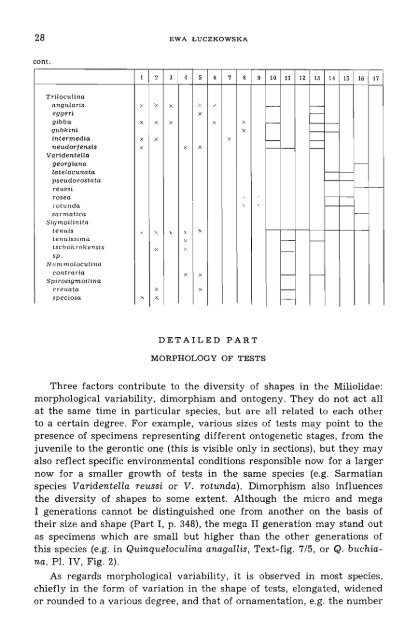MILIOLIDAE - Acta Palaeontologica Polonica
MILIOLIDAE - Acta Palaeontologica Polonica
MILIOLIDAE - Acta Palaeontologica Polonica
Create successful ePaper yourself
Turn your PDF publications into a flip-book with our unique Google optimized e-Paper software.
28<br />
EWA LUCZKOWSKA<br />
cont.<br />
1<br />
I 2 3 4 5 6 7 8 9 10 11 12 13 14 15 16 1 17<br />
TrilocuZina<br />
anguZaris X X X X X f--- -<br />
eggeri X t---<br />
gibba X X X X X t---<br />
gUbkini<br />
X<br />
intermedia X X X<br />
neu,dorfensis X X X<br />
t--- -<br />
: georgiana<br />
\faridentella<br />
-<br />
lateZacunata<br />
pseudocostata<br />
reussi<br />
rosen<br />
rotunda ,<br />
...<br />
,<br />
sarmatica<br />
Sigmoilinita<br />
tenuis<br />
x<br />
" x<br />
\. X tenuissima x t---<br />
tschok rakensis X x<br />
t---<br />
sp.<br />
-<br />
Ntlnlmoloculina<br />
contraria<br />
Spirosigmoilina<br />
x X t--- -<br />
erenata x x t---<br />
speciosa x x I--<br />
t---<br />
DETAILED PART<br />
MORPHOLOGY OF TESTS<br />
Three factors contribute to the diversity of shapes in the Miliolidae:<br />
morphological variability, dimorphism and ontogeny. They do not act all<br />
at the same time in particular species, but are all related to each other<br />
to a certain degree. For example, various sizes of tests may point to the<br />
presence of specimens representing different ontogenetic stages, from the<br />
juvenile to the gerontic one (this is visible only in sections), but they may<br />
also reflect specific environmental conditions responsible now for a larger<br />
now for a smaller growth of tests in the same species (e.g. Sarmatian<br />
species Varidentella reussi or V. rotunda). Dimorphism also influences<br />
the diversity of shapes to some extent. Although the micro and mega<br />
I generations cannot be distinguished one from another on the basis of<br />
their size and shape (Part I, p. 348), the mega II generation may stand out<br />
as specimens which are small but higher than the other generations of<br />
this species (e.g. in Quinqueloculina anagallis, Text-fig. 7/5, or Q. buchiana,<br />
PI. IV, Fig. 2).<br />
As regards morphological variability, it is observed in most species,<br />
chiefly in the form of variation in the shape of tests, elongated, widened<br />
or rounded to a various degree, and that of ornamentation, e.g. the number
















